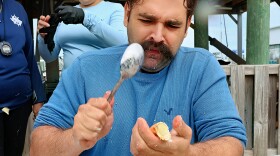Scientists on Florida’s blue green algae task force began the daunting task this week of trying to craft recommendations for how to fix the state’s complex water problems.
During back-to-back meetings in Naples, the six-member panel whittled the problems down to broad topics: pollution from the agricultural industry, septic tanks, aging sewer systems and stormwater, water quality and health threats.
How those topics get addressed specifically still needs to be hammered out, but some general recommendations in a draft document include:
- Restructuring basin management plans that govern water bodies to include better modeling and assessing how effective they are.
- Better management of plans to limit farm pollution. The plans north of Lake Okeechobee have been chronically underfunded with little enforcement from state regulators. Scientists say the state also needs access to the kinds and amounts of nutrients, including fertilizers, farms are using on land.
- Stricter oversight of septic tanks including increasing the authority of the Florida Department of Environmental Protection. More prohibitions for allowing tanks in sensitive areas.
- Better and more strategic monitoring that can help identify and solve water problems.
- More sampling for algae and more research into health impacts from chronic exposure. While damage from toxic levels is well understoond, the group said more needs to be understood about ongoing exposure to lower amounts.

The group was originally slated to vote on a report crafted by chairman Tom Frazer Wednesday after meetings derailed by Hurricane Dorian were rescheduled. But following grumblings from environmentalists about the fast pace, and numerous revisions suggested by other board members, Frazier made clear his draft was a starting point.
“This is not the last meeting of the Blue Green Algae Task Force for sure. It’s a work in progress,” said Frazer, a University of Florida aquatic ecologist named chief science officer — the state’s first — by Gov. Ron DeSantis. “It’s part of an ongoing process and some of the detail type recommendations that you’re hearing will provide the basis for more specific and focused discussions. There’s a lot that needs to be ironed out.”
Finding solutions to the complex problems won’t be easy, facing political, regulatory and economic hurdles — a challenge not unnoticed by the members.
“By the time they’re done with this report we don’t want everyone to kind of slit their wrists and say, oh my God, the future. The sky is falling, let’s go home,” UF hydrologist Wendy Graham said during a discussion of aging sewer systems.
Since June, the group has held meetings around the state gathering information from state agencies, regulatory officials and experts on how pollution and water are handled. They heard about how watersheds are managed, how farmers try to control pollution, aging sewer systems that in one case included wood pipes and how septic tanks get regulated.
The group was formed by DeSantis following an election preceded by devastating red tides on Florida’s west coast that littered beaches with dead fish and shuttered business and ongoing toxic freshwater algae blooms in the Calooshatchee and St. Lucie rivers.
On Wednesday, the scientists agreed that freshwater problems and pollution in Lake Okeechobee, should be their focus but also acknowledged that pollution from other sources that foul coastal waters can't be ignored.
The state has been trying to clean up the lake since the 1980s, but has repeatedly pushed back deadlines for meeting deadlines. Today, levels of phosphorus in the lake remain 200 tons a year more than the limit set in 1989.
The task force is trying to tackle two tools the state uses to address pollution from farms: basin management action plans that look at pollution throughout the watershed and contracts with farmers for pollution limits, called best management practices that have been chronically underfunded.
Scientists say the fixes won’t be easy.
“We’re facing challenges from blue green algae that are becoming more complex with climate change [and] warming temperatures,” said Valeria Paul, director ofthe Smithsonian Marine Station in Fort Pierce. “Cyanobacteria have been around for three a half billion years and they’ve adapted to just about everything.”
An earlier version of this story misspelled Chief Science Officer Tom Frazer's name.
Copyright 2020 WLRN 91.3 FM. To see more, visit . 9(MDAyMTYyMTU5MDEyOTc4NzE4ODNmYWEwYQ004))








